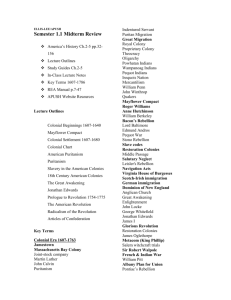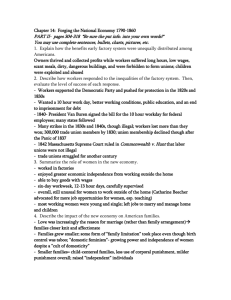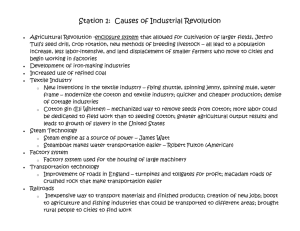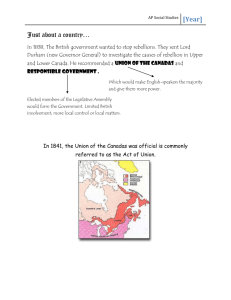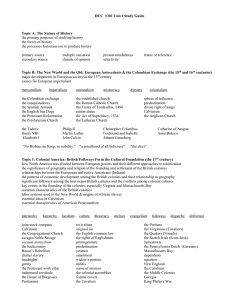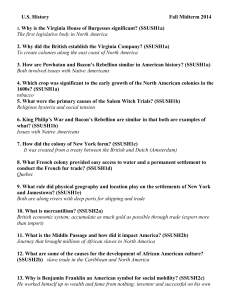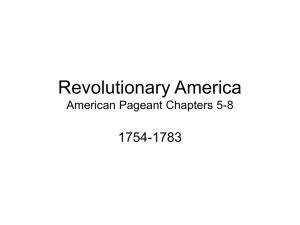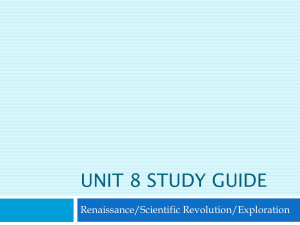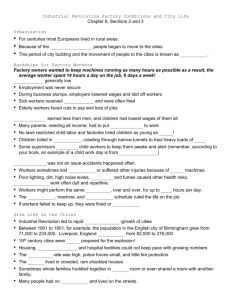Unit 2 Industrial Revolution and Imperialism
advertisement
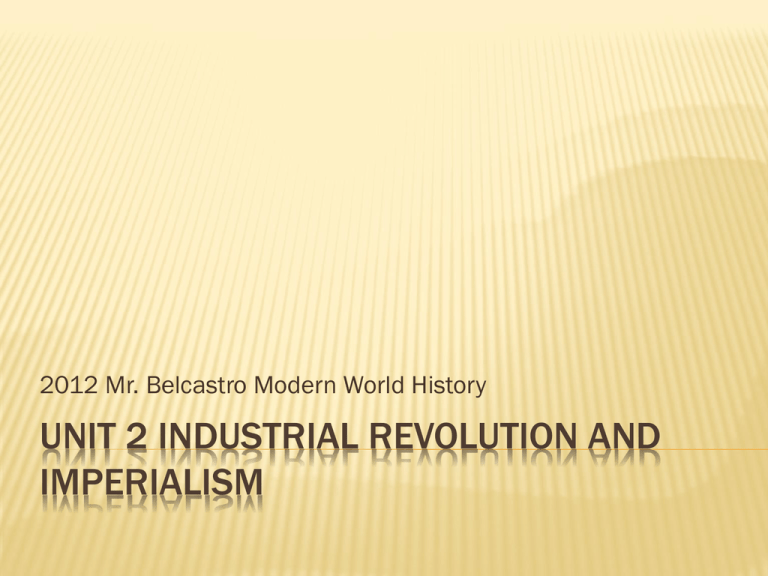
2012 Mr. Belcastro Modern World History UNIT 2 INDUSTRIAL REVOLUTION AND IMPERIALISM 1. THE AGRICULTURAL CHANGES WHICH TOOK PLACE IN ENGLAND DURING THE 1600S CONTRIBUTED TO ENGLAND’S LATER INDUSTRIAL DEVELOPMENT BY 1. 2. 3. 4. A. strengthening the importance of the family farm. B. breaking large estates into smaller farms. C. encouraging city dwellers to return to farming. D. producing more food with fewer workers. 2. LOUIS PASTEUR’S RESEARCH INTO GERM THEORY IN THE NINETEENTH CENTURY IS SIGNIFICANT BECAUSE IT 1. 2. 3. 4. created safety standards for machine workers. led to techniques that increase crop production. identified the importance of vitamins to nutrition. proved that cleanliness helps to prevent infections. THE STREETS WERE HOT AND DUSTY ON THE SUMMER DAY. STOKERS EMERGED FROM LOW UNDERGROUND DOORWAYS INTO FACTORY YARDS, AND SAT ON STEPS, AND POSTS, AND PALINGS, WIPING THEIR SWARTHY VISAGES, AND CONTEMPLATING COALS. THE WHOLE TOWN SEEMED TO BE FRYING IN OIL. THERE WAS A STIFLING SMELL OF HOT OIL EVERYWHERE. THE STEAM-ENGINES SHONE WITH IT, THE MILLS THROUGHOUT THEIR MANY STORIES OOZED AND TRICKLED IT. —CHARLES DICKENS, HARD TIMES, 1854 3.THE HISTORICAL ERA MOST LIKELY REFERRED TO IN THIS QUOTATION IS THE 1. 2. 3. Industrial Revolution. Great Awakening. French Revolution. 4 IN THE NINETEENTH CENTURY, LABOR UNIONS DEVELOPED MOSTLY IN RESPONSE TO 1. 2. 3. 4. A increasing unemployment. B government ownership of businesses. C wages and working conditions. D racial and gender discrimination. 5. TO INCREASE PRODUCTION OUTPUT DURING THE INDUSTRIAL REVOLUTION, BUSINESSES PRIMARILY INVESTED IN 1. 2. 3. 4. workers’ wages. machinery. training. marketing. 6. IN THE MID-1700S, HOW DID TRADE CONTRIBUTE TO THE EARLY GROWTH OF AN INDUSTRIAL ECONOMY IN GREAT BRITAIN? 1. 2. 3. 4. It allowed the British to educate their workforce. It provided funds to pay high wages to the new labor class. It enabled British merchants to hire skilled foreign laborers. It gave British entrepreneurs the capital needed to open new factories. 7. THE AMERICAN CIVIL WAR DECREASED EUROPE’S SUPPLY OF COTTON FROM THE AMERICAN SOUTH. WHAT DID THE EUROPEANS DO TO MAINTAIN THE FLOW OF THIS NATURAL RESOURCE FOR THEIR TEXTILE INDUSTRIES? 1. European factory owners agreed to pay a higher price for American cotton. 2. European factory owners supported abolition of slavery to end the Civil War. 3. European factory owners turned to Egypt and India as new sources of cotton. 4. European governments intervened militarily to force the resumption of the trade in cotton. 8. WHAT LATE-EIGHTEENTH-CENTURY EUROPEAN ARTISTIC MOVEMENT AROSE AS A REACTION AGAINST CLASSICISM’S EMPHASIS ON REASON? 1. 2. 3. 4. impressionism realism romanticism surrealism 9. THE SOCIAL CRITICISM OF CHARLES DICKENS’S NOVELS HARD TIMES AND DAVID COPPERFIELD WAS A RESPONSE TO CONDITIONS BROUGHT ABOUT BY 1. 2. 3. 4. colonial conflicts. industrialization. unionization. parliamentary reforms. 10. AT THE END OF THE 1800S, COLONIES WERE GENERALLY SEEN AS A 1. 2. 3. 4. place to banish criminals. sign of a country’s relative power. location to train military forces. method for suppressing nationalism. 11. ECONOMICALLY, WHAT ENABLED JAPAN TO BECOME A COLONIAL POWER AFTER 1894? 1. 2. 3. 4. Agricultural advances increased the population and forced Japan to look for new land. Japanese trade wars against the United States removed regional competition for colonies. Industrialization allowed Japan to expend resources on military and colonial expansion. The Japanese were forced to acquire colonies in Asia when European trade was banned. 12. IN THE LATE NINETEENTH CENTURY, THE BRITISH COMMONLY REFERRED TO THE SUEZ CANAL IN EGYPT AS THE “LIFELINE OF THE EMPIRE” BECAUSE IT 1. 2. 3. 4. held large deposits of coal needed by British industries. provided a strategic shipping route to British colonies. served as a ship-building center for the British navy. irrigated several cash crops in the British colonies. 13. IN 1900, ANTI-FOREIGN SENTIMENT IN CHINA LED TO AN UPRISING KNOWN AS THE 1. 2. 3. 4. Nian Rebellion. Boxer Rebellion. Taiping Rebellion. Sepoy Rebellion. 14. THE COLLAPSE OF THE LAST CHINESE EMPIRE IN 1912 WAS CAUSED BY THE IMPERIAL GOVERNMENT’S FAILURE TO 1. 2. 3. 4. control foreign influence. educate the masses. enter into alliances with other nations. repel communist guerrillas. 15. MOHANDAS GANDHI USED HIS PHILOSOPHY OF NONVIOLENT NONCOOPERATION IN AN EFFORT TO 1. 2. 3. 4. form a Marxist government in India. convince his fellow Indians to support the Allies in World War II. persuade Pakistanis to separate from India. achieve India’s independence from Great Britain. 16. BY 1914, ETHIOPIA AND LIBERIA WERE THE ONLY TWO AFRICAN COUNTRIES TO 1. 2. 3. 4. establish democratic governments. develop industrial economies. retain their independence. colonize other nations.
